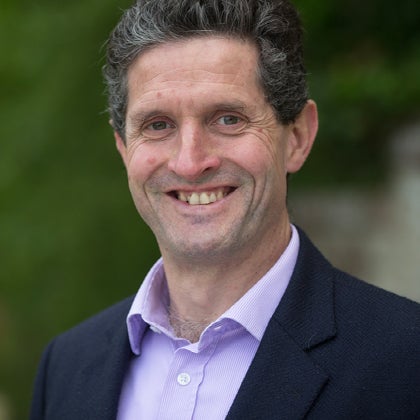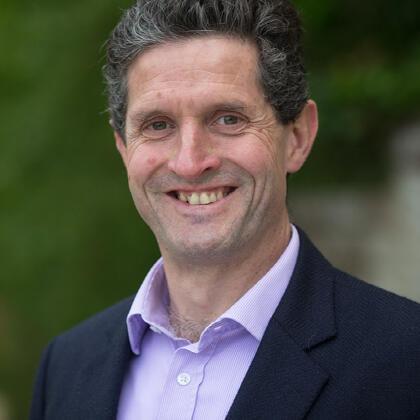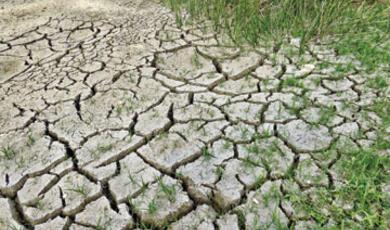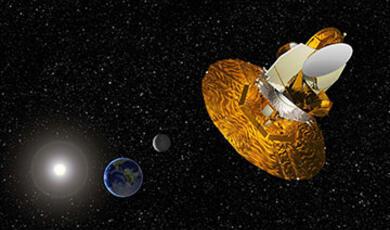The Carbon Cycle Behind Net Zero
Share
- Details
- Text
- Audio
- Downloads
- Extra Reading
What happens to carbon dioxide after we emit it? Half is absorbed within a year or two by plants and the oceans, the rest, in effect, stays in the atmosphere. So, does that mean we have to halve emissions to stop concentrations rising? Unfortunately, no.
Despite the vast reserves of carbon dissolved in the oceans, carbon dioxide released by burning fossil fuels does not get diluted away, but makes an indelible mark on climate for hundreds of thousands of years.
Download Text
The Carbon Cycle Behind Net Zero
Professor Myles Allen
8th March 2023
The first thing you notice about the “Keeling curve” – Charles David Keeling’s observations of atmospheric CO2 concentrations taken at Mauna Loa in Hawaii, as far as he could get from any local sources of pollution – is that it’s going up. From around 315 parts per million when he started these observations, to around 420 parts per million today. That’s an extra 800 billion tonnes of CO2 in the atmosphere in less than 50 years, or over one third of the total CO2 that was in the atmosphere naturally before James Watt invented the steam engine. It’s also accelerating, as the rate at which we are pouring carbon dioxide into the atmosphere has increased, and is still increasing, the odd financial crisis, climate agreement or global pandemic notwithstanding, year on year. And finally, it zig-zags up and down, with size of the annual cycle in CO2 concentrations in Hawaii (it’s very different in other parts of the world) being comparable to about 5 years’ worth of human-induced increase. That zig-zag is the first hint that CO2 is not quite as simple a pollutant as, say, CFCs are. There are no natural sources of CFCs, but in burning fossil fuels we are dumping carbon dioxide into a vast, complex, but fortunately quite predictable and well understood, natural carbon cycle.
This complexity is revealed when we look at an animation of carbon dioxide concentrations in the atmosphere over a typical recent year, 2020-21. Yes, you may think there was a lot going on in 2020, but to be honest, Mother Nature barely noticed our lockdowns and flight bans. Transparent air in this animation doesn’t mean there is no CO2 there at all, just that the concentration is no higher than the global average concentration was in the middle of 2020 when this animation starts. You can see straight away the first wisps of higher-CO2 air emerging from our tropical rainforests. These, the lungs of the planet, absorb lots of CO2 but they also breath it out again, over the course of a day and over the course of a year. As the animation continues, we see the temperate forests of the northern hemisphere joining in, releasing vast amounts of CO2 as leaves fall and decay in the Autumn, driving up the global average CO2 concentrations in just a few months by over 5 years of human-caused emissions. But then, as if by magic, but as predictable as spring following winter, these forests regrow and absorb much of the CO2 they have taken up, although, as you can see at the end of the year, there is still some left over. That is because of the extra CO2 we have put into the atmosphere, driving up concentrations by over two parts per million per year.
There are human activities that produce carbon dioxide directly, like burning fossil fuels. There are natural processes that exchange carbon dioxide between the atmosphere, oceans and biosphere. And there is an important third category that is the indirect impact of past human activities, such as plants growing faster because of the extra CO2 we have already pumped into the atmosphere. Is that human-caused, or is it natural? This is the source of much confusion, and we’re going to talk about this a lot, because it is confusion that risks fatally undermining our collective efforts to halt global warming.
This may sound alarmist, but I believe this is a very real problem right now, and unfortunately, it is a problem I may have personally contributed to through my naivety around 15 years ago. Back then, when we first suggested that net zero emissions of carbon dioxide would be what it would take to stop global warming, we counted this “CO2 fertilisation” effect, and the additional uptake of CO2 by the oceans that also results from historical CO2 emissions, as all just part of the natural Earth System response to “our” emissions. So, we calculated that we needed to reduce “our” emissions, meaning the direct consequences of our ongoing activities, to net zero to stop global warming.
It didn’t occur to us that anyone would want to take credit for a process that happens as an inevitable consequence of other people’s emissions. But, of course, these natural, or not-quite-natural, uptakes represent very real tonnes of CO2 being removed from the atmosphere, and these removals are taking place on someone’s land, or in some country’s jurisdiction, or into the ocean in some country’s exclusive economic zone. And now that carbon dioxide has a price, because if you remove carbon dioxide from the atmosphere you can sell it as an offset to someone else who is willing to pay to keep burning fossil fuels, suddenly all these semi-natural uptakes, which we classified as natural and the Intergovernmental Panel on Climate Change has considered natural ever since, particularly in the science that underpinned the Paris Agreement, are being claimed as “negative emissions” and sold on the offset markets.
If we count all additional uptake of CO2 into the biosphere and oceans as a negative emission and claim that it compensates for ongoing fossil fuel emissions, then achieving net zero is no longer enough to stop global warming: all it will achieve is stabilisation of atmospheric concentrations of CO2 which, as we discovered in lecture 2, is only enough to slow, not stop, the rise in global temperatures, at least for many centuries.
You may think “what’s the problem, it’s just an accounting issue, just close the loophole.” But that is harder than you think: distinguishing between an additional tonne of CO2 absorbed by a forest because of more CO2 in the atmosphere (which we called natural) and a tonne absorbed because of a change in forest management (which we counted as a human-caused negative emission) is often completely impossible. In any case, making a hard distinction might have all kinds of undesirable side-effects, such as encouraging people to neglect protection of indigenous old-growth forests, that have all kinds of benefits for biodiversity, in favour of new plantations because they can take credit for the carbon taken up on the latter.
Fortunately, there is a simple solution, which is to recognise that an essential part of any durable net zero, any sustainably balanced global carbon cycle, is geological net zero: that is, a global balance between any further production of CO2 from geological sources, such as burning fossil fuels, and storage of CO2 in geological reservoirs, such as reinjecting it back underground. Unlike the complexities of the biosphere, geological net zero is very simple to define and monitor, because there are no natural flows of carbon into or out of our geosphere on any scale. So we need to get to geological net zero, and we need to do it by mid-century to have any chance of meeting the goals of the Paris Climate Agreement.
Unfortunately, until recently, not a single official document had acknowledged the eventual need for geological net zero, never mind committing any country, region or company to contribute towards it. And, meanwhile, ever more corporate net zero strategies emerge that seem to depend on turning rocks into trees. I’m delighted to say that has now changed, and in the highly influential – or, at least, I hope highly influential – Skidmore review of the UK’s Net Zero strategy, Chris Skidmore calls for the government to “recognise the importance of geological net zero and work to align international ambitions towards geo zero by 2050.” The government, I believe, is due to respond this month. Let’s see what they say.
© Professor Allen 2023
References and Further Reading
- David Archer, The Long Thaw
- The Global Carbon Project, https://www.globalcarbonproject.org/
References and Further Reading
- David Archer, The Long Thaw
- The Global Carbon Project, https://www.globalcarbonproject.org/
Part of:
This event was on Tue, 07 Mar 2023
Support Gresham
Gresham College has offered an outstanding education to the public free of charge for over 400 years. Today, Gresham College plays an important role in fostering a love of learning and a greater understanding of ourselves and the world around us. Your donation will help to widen our reach and to broaden our audience, allowing more people to benefit from a high-quality education from some of the brightest minds.


 Login
Login







